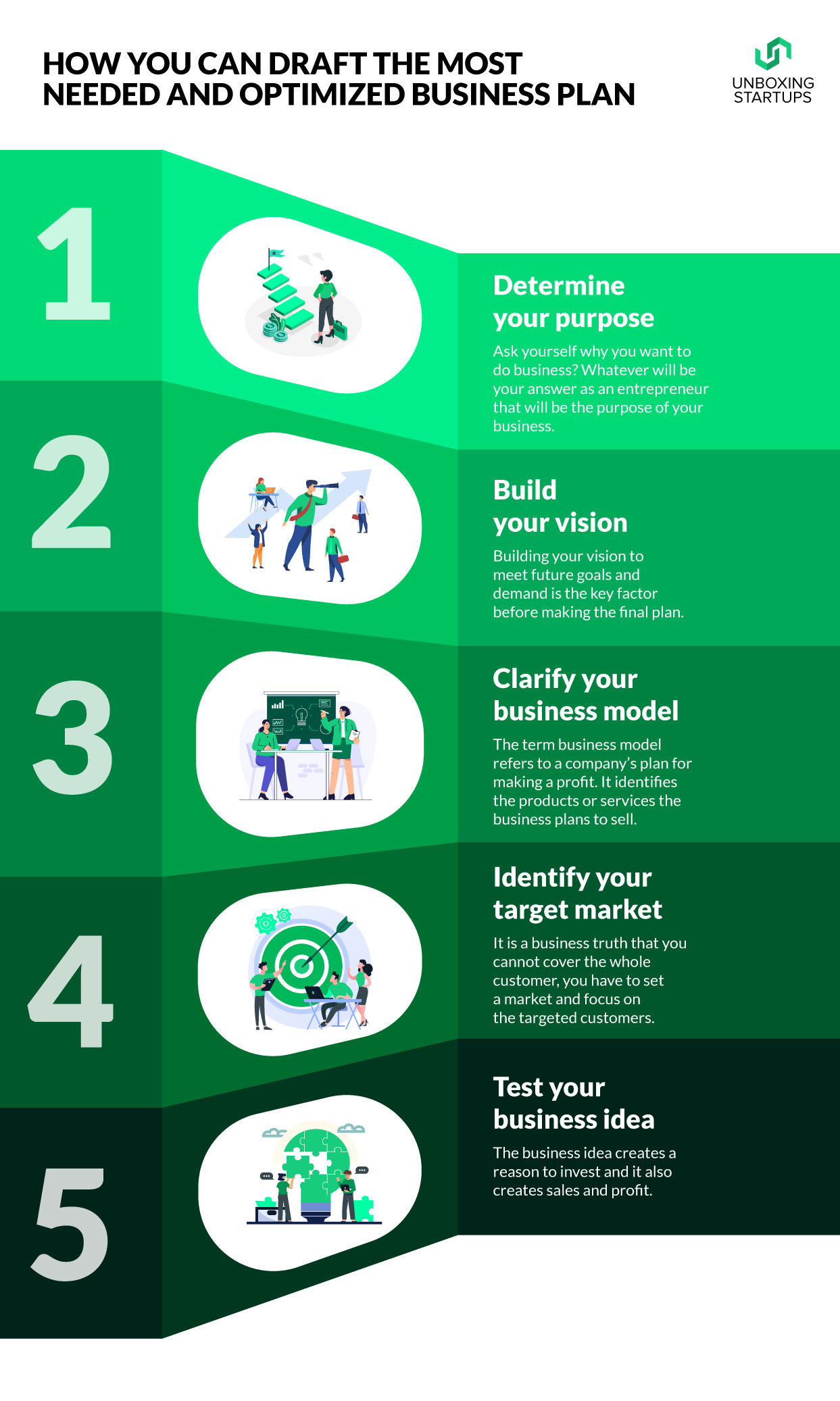
How You Can Draft the Most Needed and Optimized Business Plan
| 9 minutes read
A business plan is a document that recapitulates the operational and financial objectives of a business. It is a business road map to success with detailed strategies and budgets that demonstrate how the objectives will be realized.
Making a plan is not enough, you’re required to implement a plan according to the capabilities and financial position of your company. But, never the least, it widens the scope of possibilities with great teamwork and business goals.
What is a Business Plan?
A business plan is a carefully strategized statement of business goals. It is written on behalf of an established business or a startup, it includes reasons the goals are attainable, along with plans for achieving them. Most business plans include background data about the individuals, organizations, or teams who will be responsible for making these goals reality.
In short, a business plan simply means analyzing, planning, researching about the company. The outcome which comes out is the business plan which takes your company forward to meet with customer expectations.
The Purpose of a Business Plan
A business plan is essentially a decision-making tool. Its content and format are resolute both by the business’s goals and by the intended audience. It is crafted to ask for a loan to start a new company or expand an existing one, and it is also used by investors to provide funds, on the other hand, focuses primarily on the business’s ability to repay the loan on schedule time. Business without a plan is like walking blindly on track.
The purpose of a business plan is to help eloquent a strategy for starting your business. It also provides insight on steps to be taken, resources required for achieving your business goals, and a timeline of expected results.
Who Needs the Business Plan?
Anyone who would like to invest in your company asks for a business plan. A business plan shows the complete details of your business and it also shows you what strategy you’re adopting for future challenges. Entrepreneurs who are starting a new business often wonder, “Do I need a business plan? Is planning and writing a business plan the best use of my time?” The answer to these questions is almost always, “Yes.” A business plan is an integral part of starting a new business. Without a proper plan, you will distract yourself before you start your business.
- You need a business plan if you’re running a business: A business plan is like a map and a blueprint for a business. Without it, you’re traveling blind. With a plan, you set purposes, establish priorities, and provide for cash flow.
- You need a business plan if you’re applying for a business loan: If you are required for a business loan, most banks ask about your business plan. They expect an overall summary of the business, with some predictable key points.
- You need a business plan if you’re looking for business investment: If you don’t have a plan investors will not show interest in investing in your business. They invest in the people, the idea, the track records, and other factors; but they look to the business plan to define and explain the business.
Things to consider before start working on a business plan
Before building a business plan there are few crucial things you need to care about, first and foremost thing is to understand and ask yourself, why are you doing this?
Do you have a backup in a case of initial financial loss? Where do you want to reach in the next two years? Who will be your target customers? And how will your core team be?
We are going to scale out five crucial things you need to consider before drafting out your business plan.
Let’s find out:
-
Determine your purpose
What is the purpose of your business? We know many will say profit, but it can not be the only purpose in business. You have to think and decide what will be your vision and mission before stepping further. In simple words, ask yourself why you want to do business? Whatever will be your answer as an entrepreneur, that will be the purpose of your business.
-
Build your vision
Building your vision to meet future goals and demand is the key factor before making the final plan. You have to get confirmation about your future vision of your company,
Where do you want to reach in the next three years? How can you be different from your competitors? These are the questions you have to answer if you’re an entrepreneur.
-
Clarify your business model
The term business model refers to a company’s plan for making a profit. It identifies the products or services the business plans to sell. It identified the target market and any anticipated expenses. Business models are important for both new and established businesses.
-
Identify your target market
It is also one of the crucial things every entrepreneur has to think about. Before drafting a plan you have to think about your customers. Who will be your target customers, and to whom you’re targeting? A product can only be made for selected target customers, it is a bitter business truth that you can not cover the whole customer, you have to set a market and focus on the targeted customers.
-
Test your business idea
The business idea creates a reason to invest and it also creates sales and profit. The high sales and profits encourage investment in more products and services, enabling the business to grow. It is the pure essence of capitalism. All that said, if you have a bad idea, you are more likely to face competition.
What are the key components of a Business Plan
It is the case usually with most big projects, crafting a business plan is one of those things that takes an incredible amount of diligence and no shortage of courage. After all, your business idea is probably more than just some detached money-making ploy — you dream that you’re getting ready to lay bare for the world to scrutinize!
If you approach this with a firm understanding of what crucial information to include in each section of your business plan and know how each section works together to form a cohesive, and — above all — persuasive whole, it will make the writing process a whole lot less daunting.
We’re here to help you do exactly that by reviewing each of the core components of your business plan one at a time and showing you exactly what information you should present to your readers. So when it is done, you can walk away confidently knowing you’ve confined the most effective business plan possible.
-
Executive Summary
We know a great movie trailer gives you a basic understanding of what the film is going to be, while also enticing you to go check out the full-length feature, your Executive Summary serves as an overview (a glimpse) of the main aspects of your company and business plan that you will discuss in rest of your plan.
In other words, your Executive Summary is your business plan’s highlight reel.
Remember, you’re not giving away every detail of your business plan right upfront. Just enough of the “good parts” to both inform and plot your reader to dig in further.
You do this by presenting a concise outline of the following information:
Mission Statement
A “big idea” statement that introduces why your company exists, what it does for your consumers, and why does it matter.
Product/Service Summary
A brief description of your company’s products or services, with a special prominence on what makes them unique.
Market Opportunity Summary
A quick explanation of the one or two key problems and/or trends your product/service addresses, and how it translates to a big opportunity for your company (and investors).
Market Overview
The problem and solution statements help to set the stage and provide readers with insight into why you’re starting this company, clearly defining your market will allow you to call attention to the trends and industry conditions that validate why now is the time for your company to succeed.
You’re going to boost your expertise with plenty of evidence in the form of market statistics and research to show readers that you’re not only an expert when it comes to your product, but your industry as well.
Your goal here is to help illustrate:
-
- The SIZE of the market opportunity your company is positioned to address
- The amount of GROWTH occurring in your market
- The TRENDS driving the demand for your solution
- The SUCCESS STORIES happening with competitors in the industry
Market Size & Growth
Influencing your readers that your problem covers a big market and it will play a huge role in how excited they’ll be while getting involved in helping your company. This is where you’ll want to put your research cap on and start uncovering some numbers that help your reader better understand:
-
- How big the market is (locally/nationally/internationally)
- Approximately how much revenue it generates every year
- How much it’s expected to grow over the next 5-8 years
-
Customer Definition
The actual game here is to know your audience!
This is where you show readers that you know who your audience is (who’s most likely to buy and use your product), where they are, and what’s most important to them. Are they price-conscious? Do they tend to be early adopters of new technologies?
Once you have a good idea of your customer identities and demographics, you’ll get an idea and then you want to explain how you’re designing your products/services, branding, customer service, etc. to appeal to your target audience and meet their needs.
Key questions to consider:
-
-
- Who are the people that your product/service is designed to appeal to?
- What do you know about customers in this demographic?
- What age range do your target customers have?
- Around how many people are there in this target demographic?
- Where do your target customers live?
- How much money do they make?
- Do they have any particular priorities or concerns when it comes to the products/services they buy
-
-
Sales
It is the common question that every business entrepreneur has had to answer: How will your company make money?
If you’re just starting, clearly defining your framework for maximizing sales might seem like somewhat of a shot in the dark. But showing investors you have even a superficial idea of how you will convert your product or service into sales is fundamental in lending credibility to your business plan.
Once the market has been researched and examined, conclusions need to be developed that will supply a measurable outlook concerning the potential of the business. The first financial projection within the business plan must be formed utilizing the information drawn from defining the market, positioning the product, pricing, distribution, and strategies for sales. Most business plans will project revenue for up to three years, although five-year projections are becoming increasingly popular among investors.
-
Pricing
How you price your product is one of the important factors between failure and success. Though pricing strategy and computations can be complex, the basic rules of pricing are straightforward:
- All prices must cover costs.
- The best and most effective way of lowering your sales prices is to lower costs.
- Your prices must reflect the dynamics of cost, demand, changes in the market, and response to your competition.
- Prices must be established to assure sales. Don’t price against a competitive operation alone. Rather, price to sell.
- Product utility, longevity, maintenance, and end-use must be judged continually, and target prices adjusted accordingly.
-
Funding
Chances are you’re shopping your business plan around to secure capital for your project. If that’s the case, don’t forget to ask for the one thing you set out to achieve!
You’ll want to dedicate an entire section to your request for funding. This is your only opportunity to tell investors:
- What your funding goals are?
- How can they actually help you to achieve those goals?
- What they can get from getting involved in your company?
Funding Goal
How much funding do you need to move forward with your set goals? How did you arrive at this figure?
Terms
What will investors get back for their investment in your company?
Use of Funds
How will you use the funding structure that you secure from investors? Provide a very basic breakdown, either by amounts or by percentages. For example:
-
- Investing 25% of funds in R&D
- Investing 25% of funds in Marketing
- Investing 25% of funds in Product Development
- Investing 25% of funds in Key Hires
Milestones
You have to know what key milestone your company will achieve with the help of this funding.
Summing up Funds
Wrap up your funding section by driving home why investors should get involved with your company. Is it the experience of your team? The originality of your product? The size of the market? Identify a few key factors in your business and unlock a great opportunity from an investment perspective.
What are the Successful Financial Strategies for Long Term Business Plan?
A large part of the business plan for any startup is the financial section of the plan. The financial section includes the income statement, cash flow statement, and balance sheet. For new businesses, these financial statements will be projections, whereas for an existing business the section will contain several years of history as well as projections. In addition to statements, the plan should include the financial strategies of the business in how finances will be handled.
Planning for Purchases
Any purchases made through the business should have detailed guidelines in the business plan. This will confirm which purchases will be made with cash, a line of credit, and a credit card. This strategy will also outline taking advantage of the terms of suppliers. For instance, if a supplier offers 40-day terms, the business will wait until the end of the term to make a payment. Also, the purchasing strategy should specify if approval is needed by a manager for purchases over a certain amount.
Pursuing Outstanding Bills
If the business is not properly managing it’s own receivable, it can be upsetting to the financial health of the business. The financial strategy should point to the collection plan. This may include dedicating in-house staff to following up with overdue customers or turning them over to an outside agency. It will also specify late fees and if deposits are due before products and services are delivered for new customers.
Investments for Growth
Although a specific investment strategy may not be able to be detailed in a written plan, general guidelines should be given to management. This includes a percentage of money invested in high-risk portfolios vs. lower-risk portfolios. The investment section of the plan will also include guidelines of when approval is needed to make changes to current investments to cover business necessities.

Born in the family of entrepreneurs and have inherited the same. Started building applications in order to pay for my tuition. Later founded a tech company, marketing agency, and media outlets.


